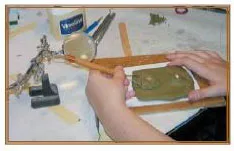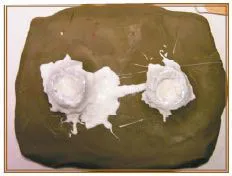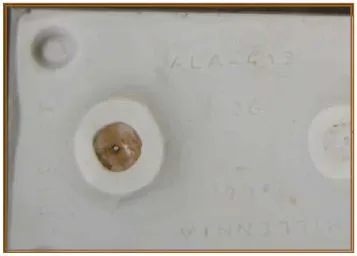![]()
PART I.REPLICA SET PURPOSE AND HISTORY
By Al W. Schwitalla
OVERVIEW OF THE PROJECT
For at least 10,000 years the indigenous people of California manufactured beads from the shells of the marine snail genus Olivella, a native to the gravelly intertidal areas along the Pacific coast. Olivella beads were modified into many shapes—some from near-entire shells, others cut from the shell body walls. Archaeologists recognized in the 1930s that Olivella shell bead forms changed over time and were therefore useful markers of temporal succession. A bead typology soon developed and bead types came to be used, much like southwestern pottery sherds, as a means of relative dating of a given archaeological site or series of super-imposed site components (Gifford 1947; Lillard, Heizer and Fenenga 1939).
The widely accepted typology currently used by central California archaeologists to classify Olivella shell bead types is that established by James A. Bennyhoff and Richard E. Hughes in 1987. The typology is designed to distinguish temporally significant differences in bead attributes. Despite its inclusion of 380 shell bead illustrations, the Bennyhoff and Hughes monograph can be difficult to use, due to “fuzzy” boundaries between many of their bead types.
In 1993, Robert Jackson and I, then with BioSystems Analysis, Inc. and now with Pacific Legacy, Inc., conceived the idea of a replica set for the Bennyhoff and Hughes Olivella shell bead types while working together on contracts involving the manufacture of polymer-based reproductions of native California artifacts. Some of those contracts included the production of dozens of Olivella shell bead replicas. In 1995, Lisa Deitz, the senior museum scientist at the Museum of Anthropology at UC Davis, contacted me with the intention of purchasing a set of Olivella shell bead replicas for the university. Many of the bead types illustrated in the Bennyhoff and Hughes (1987) monograph had not yet been replicated. It was during these early conversations that a cooperative partnership developed between the Anthropology Museum at UC Davis and Millennia Molding and Casting Company, resulting in a joint 1998 proposal submitted to the Phoebe A. Hearst Museum of Anthropology at UC Berkeley to access and borrow the original type collection housed at the museum and illustrated in the 1987 monograph (Schwitalla 1998). In the summer of 2000, the Hearst Museum declined to participate in this project, citing concerns over physical and intellectual control over the bead impressions once they were no longer in the Museum’s possession.
In 2001, Randy Milliken and I were awarded a grant from Pacific Legacy, Inc. to jointly pursue the bead replication project. Randy would choose appropriate bead type specimens for replication and I would manufacture the molds from the original type specimens and create casts of each bead. An important aspect of the grant included the development of this Guide, which refined and revised Bennyhoff and Hughes (1987), as needed, documenting added bead types and variants and providing supporting documentation for temporal associations.
The project began during the winter of 2002-2003 as we contacted institutions and firms known to hold examples of various Olivella bead types. We visited these facilities to examine bead lots and negotiate the loans of beads for reproduction. Below we describe the history of the Replica Set’s creation and acknowledge the help of the many individuals, institutions and cultural resources management firms involved.
Thirty type examples were identified initially in a bead collection from the estate of James A. Bennyhoff, which Randy had in his possession. Randy found another six beads among a collection from archaeological site CA-YOL-69 that he was analyzing for Holman and Associates and secured permission to reproduce them from Holman project supervisor Randy Wiberg and from Patwin descendant Kesner Flores. Another two beads were discovered in a type collection from CA-ALA-343 on loan for a comparative study of Class F Saddle beads. Permission was received from George Rogers of Ohlone College and Ohlone descendant Andy Galvan to reproduce them.
Randy made eight visits in 2002 to California State University, Sacramento, where he examined collections for appropriate bead examples and obtained the permission of Dr. Jerry J. Johnson for the loan of 32 beads for replication. He also visited the Santa Barbara Museum of Natural History, where he obtained permission from Curator of Anthropology, Dr. John Johnson, for the loan of 17 beads. In addition, Randy arranged the loan of an important type collection from Robert Gibson of Gibson’s Archaeological Consulting in Paso Robles, California. Thirteen beads from Gibson’s collection were replicated.
Another bead collection trip was made to the firm of Archaeor, Inc. in Fremont, California, where Randy borrowed 12 bead examples for replication from collections under analysis by principals Andy Galvan and Rick Thompson.
Randy examined collections at the University of California, Davis on January 16, 2003, and with the cooperation of Dr. Robert Bettinger and Lisa Deitz, he identified and borrowed 28 Olivella bead type examples for replication.
Still lacking in the growing type assemblage, however, were beads representing Type G6 and classes L and N. Randy visited the University of California, Santa Cruz on January 23, 2003 and borrowed four Type G6 beads with the permission of museum curator Dianne Gifford-Gonzales. Four Class L beads were obtained from the type collection of Dr. Robert Cartier of the firm Archaeological Resource Management in San Jose, California and one Type A4c bead was borrowed from a collection at Far Western Anthropological Research Group, Inc. in Davis, California, courtesy of Principal Pat Mikkelsen. A perfect example of a Type C2 Split Shelved bead was chosen for the project from among my molds and casts of beads excavated in 1999 at the Emeryville Shellmound (CA-ALA-309).
By the end of January 2003, only Class N Grooved Rectangles were missing from the bead type assemblage for the project. Six of the original Class N beads illustrated by Bennyhoff and Hughes (1987:138) were accessioned at the American Museum of Natural History. I requested the loan of these beads for nondestructive replication and museum curator David Hurst Thomas granted this request. By April 2003, these Class N beads arrived in California, thus completing the examples needed for the Replica Set of 154 beads.
Most bead molds were completed in June of 2003 at my artifact reproduction lab, maintained at the time within the Department of Anthropology facilities at California State University, Sacramento. At the last minute, the decision was made to expand the typology to differentiate smooth-edged from rough-edged Class F Saddles beads. Two examples of smooth-edged Saddles were obtained from San Jose State University, with the assistance of Alan Leventhal. Molds for the newly-defined Olivella Saddle subtypes were produced in 2007 at the Pacific Legacy facility in Cameron Park.
DOCUMENTING REPLICA CHOICES
The process of choosing individual beads for replication was a difficult one. Most bead type examples were chosen because they closely approximated specific illustrations in the Bennyhoff and Hughes (1987) monograph. In a few select cases, beads were chosen that differed from the Bennyhoff and Hughes’ examples if they captured some notable aspect of the type. Bead type examples were also selected to document the range of variation within certain types. Examples for 13 of the rarest types illustrated by Bennyhoff and Hughes could not be obtained and therefore were not reproduced in the replica set.
During the search for appropriate examples, Randy noted descriptions that applied to more than one bead type; these overlapping descriptions had been acknowledged by Bennyhoff and Hughes in 1987. Randy also noted some ambiguities in the typology. The most problematic classifications were beads of Class E (Lipped beads), F (Saddles), J (Wall Disks) and K (Callus beads). To resolve some of these classificatory issues, Randy obtained the help of experienced Olivella bead analysts David Fredrickson, Chester King, Robert Gibson and John Johnson. The group met on January 6, 2003 at the Santa Barbara Museum of Natural History. Armed with the beads obtained for this project, personal notes, years of bead expertise and the comparative collection of the Santa Barbara Museum of Natural History; these analysts quickly reached agreement on the metrical and descriptive boundaries within and between Class E and Class K beads. They also clarified the differences between types within Class J Wall Disks. The researchers also considered the important new evidence from Randy Groza’s (2002) direct AMS bead dating study, which indicated that Bennyhoff and Hughes’s (1987:129-132) temporal seriation of Class F Saddle beads was incorrect and that their Class F type distinctions impeded recognition of the actual changes in central California bead forms during the latter half of the Middle Period. The analysts supported the important expansion of the Class F typology reported in Part II of this Guide.
BEAD REPRODUCTION PROCESS
The molding and casting of both organic and inorganic anthropological specimens has been accepted for many years as an effective and safe alternative to the handling, displaying and analyzing of original artifacts. Various molding techniques, when properly employed, capture the microscopic surface detail of an object. Thus all casts have the potential to be of high quality and exacting in detail.
Molding of cultural materials often involves both reconstructive and preservational preparation. Reconstructive preparations can include the filling of cracks and missing pieces and the gluing or re-gluing of specimens, all of which are potentially destructive. Preservational treatments of artifacts subject to reproduction generally are those designed to protect the specimens’ surfaces during the molding process, while simultaneously incurring no noticeable loss of surface detail on the mold impressions. Depending on the composition of the original object, different methods and materials may be used to preserve the original surface. Artifacts made of wood, clay, bone, or fibrous plant materials often are in various stages of decomposition and can be brittle and friable. These types of artifacts frequently require treatment with a hardening solution such as polyvinyl acetate (PVA) or one of a host of other reversible preservatives.
Fortunately, these problems were infrequent during molding of the bead specimens for this project. In general, I have found that these treatments are usually unnecessary for shell bead artifacts, as many beads recovered from archaeological deposits have retained their hard callus finish, which makes them exceptionally durable and impervious to damage from the mold preparation process. Those which appear to be susceptible to damage are protected with a thin film of PVA or talc, or the combination of both, applied to the surface of the shells to ensure that they are not damaged in any way during the molding process.
The actual manufacture of the Olivella bead molds was a lengthy process, due in part to their small size and the need for high quality (finely detailed) molds. I designed the molds for this particular project as two-part impressions, given the two-dimensional nature of most the beads. We half-embedded each bead in modeling clay, thereby preventing it from exposure to any molding compound (upper photo). The molding compound was a high fidelity silicone material.
Following this set-up procedure, we applied successive layers of silicone rubber to the surface of each bead every 24 hours (right photo), until each specimen was completely covered with hardened silicone. These prepatory stages are necessary to ensure the internal integrity of each impression for longevity of the mold. Next, we poured a plaster casing or jacket over the cured molding compound, ensuring that the mold had a rigid backing that maintained the shape of the individual bead impression—analogous to a bicycle tire and rim that are designed to fit together and confine the rubber inner-tube, thus preventing distortion. The completed half of the mold was then turned over, the clay covering the second side or half of the bead was removed (photo below) and the process was repeated until the resultant two-part mold was finished.
The bead reproductions or casts were made from a polyurethane medium that has an exceptionally low shrinkage rate, thereby ensuring that each cast maintains the same physical dimensions as the original specimen.
![]()
PART II.REPLICA SET TYPOLOGY AND COMMENTARY
By Randall T. Milliken
NAMING BEADS IS NO SUBSTITUTE FOR METRICS
It is important to begin by saying that the classification system represented by the replica beads must be regarded as a work in progress. Many of the typological boundaries that separate bead types in the current typology are based on limited examination of a small sample of prehistoric beads. Size groups within a type that currently seem unimportant may at some point demonstrate important temporal differences as more and more beads are analyzed and presented in the future.
Thus we wish to emphasize that naming beads by type is no substitute for reporting the metrical and non-metrical attributes of significant samples of beads from documented bead lots. It would be a misuse of this Replica Set Guide if future archaeologists were to use it merely to name b...



